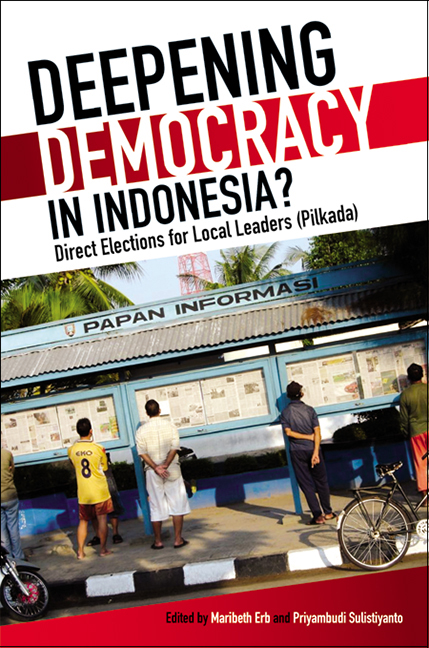Book contents
- Frontmatter
- Dedication
- Contents
- List of Tables
- List of Figures
- Contributors
- Acknowledgements
- Glossary
- 1 Indonesia and the Quest for “Democracy”
- 2 Pilkada Langsung: The First Step on the Long Road to a Dualistic Provincial and District Government
- Part I Political Parties, Politician Elites and the Voters
- Part II Media and Campaigns: Comparing Local and National Elections
- 10 Pomp, Piety and Performance: Pilkada in Yogyakarta, 2005
- 11 Assessing Media Impact on Local Elections in Indonesia
- Part III Conflict, Ethnicity, and Political Divisions
- Index
10 - Pomp, Piety and Performance: Pilkada in Yogyakarta, 2005
from Part II - Media and Campaigns: Comparing Local and National Elections
Published online by Cambridge University Press: 21 October 2015
- Frontmatter
- Dedication
- Contents
- List of Tables
- List of Figures
- Contributors
- Acknowledgements
- Glossary
- 1 Indonesia and the Quest for “Democracy”
- 2 Pilkada Langsung: The First Step on the Long Road to a Dualistic Provincial and District Government
- Part I Political Parties, Politician Elites and the Voters
- Part II Media and Campaigns: Comparing Local and National Elections
- 10 Pomp, Piety and Performance: Pilkada in Yogyakarta, 2005
- 11 Assessing Media Impact on Local Elections in Indonesia
- Part III Conflict, Ethnicity, and Political Divisions
- Index
Summary
Performance is an integral part of Indonesia's election culture. National elections — from Indonesia's first election in 1955, throughout the New Order, to Reformasi and the present — have always been marked by parades, fairs, and performances, by both performing artists and politicians themselves, as I have discussed elsewhere (Lindsay 2005, 2007). National election campaigns are in many ways one long show, with a clearly marked performance season. Live performance is integral to these campaigns: as an attraction to provide a festive atmosphere and draw crowds to party rallies (just as a family hosting a wedding or circumcision party provides entertainment for guests), as a way for a political party to highlight its endorsement by well-known artists, or to provide an opportunity for political candidates themselves to perform in another voice.
Election Day, too, despite real political tensions or even because of them, is also marked by a sense of play. It is common to find polling booths decorated as for a festive occasion, particularly weddings. Recently a new trend has emerged. At some polling booths, officials dress up in costume (traditional dance costume, for instance) or ceremonial dress (like hosts at a wedding reception), playfully emphasizing the ceremonial performance of voting.
In 2004, the year of national legislative elections and the first direct presidential election (held in two stages), this play aspect was highly evident. The main campaign performance stage, however, shifted to television, which featured celebrities (pop stars, singers, and sinetron artists) debating their political affiliations, and infotainment shows about celebrity choice. In many ways, this was a natural development from the role television began to play in the 1999 elections, when New Order media control suddenly disappeared and television was used in a highly performative way to encourage voter awareness and participation (Lindsay 2002). But the significant new aspect in 2004, particularly for the presidential election, was that voters were for the first time choosing people (and thus candidates, as personalities or celebrities) rather than parties. This fostered a tighter link between popular culture and politics, via the media.
- Type
- Chapter
- Information
- Deepening Democracy in Indonesia?Direct Elections for Local Leaders (Pilkada), pp. 211 - 228Publisher: ISEAS–Yusof Ishak InstitutePrint publication year: 2009



